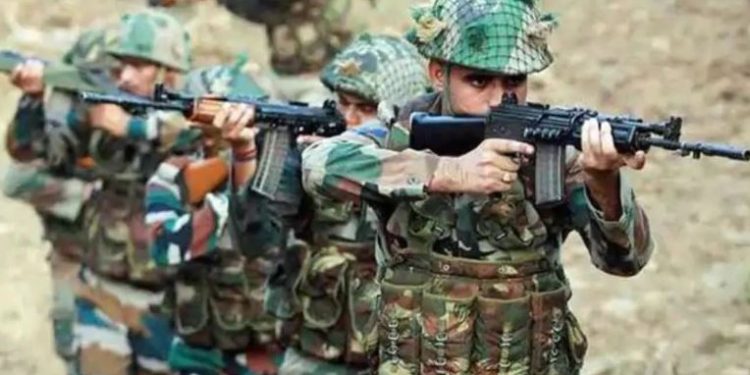New Delhi: Indian Army has set itself on a course of transformation and is working on creating a battlefield surveillance system to provide a composite operational picture to commanders and staffers at all levels for swifter decision-making, defence sources said.
The Army’s Battlefield Surveillance System is being built under ‘Project Sanjay’. It seeks to create multiple surveillance centres for the field formations and enable the integration of a large number of sensors.
Sources in the defence establishment said the Army is observing 2023 as the ‘Year of Transformation’ to set itself on a course to become a “future-ready, technology-driven, lethal and agile force” and establishes itself as an “iron cast pillar of national power”.
‘Project Sanjay’ and a host of other tech-driven projects, including one that will bring in multi-domain spatial awareness on a single GIS platform, are aimed at making the force more potent, they said.
The Battle Surveillance System will provide an integrated surveillance picture to commanders and staffers at all levels besides completing the sensor-shooter grid by integrating it with the Artillery Combat Command and Control and Communication System (ACCCS), sources said.
The ambitious project has “come of age” following extensive validation carried out in multiple terrains over a protracted period, they said.
The trials were conducted in the plains, desert areas and in mountainous terrain from August to October last year, a source said.
Bharat Electronics Limited, Ghaziabad, is the project’s system integrator. They have succeeded in meeting the Army’s aspiration in full. The contract with the supplier is now being progressed further for delivery of these surveillance centres for field formations by December 2025, he said.
These projects aim to reshape and re-engineer the functional processes and bring in a quantum jump in Army’s capabilities, the source said.
The Battle Surveillance System will give a fillip to the Army formations along the northern and western borders. It will allow commanders and others to make decisions more swiftly, boosting the Army’s overall operational preparedness, the source said.
Army Chief Manoj Pande had recently spoken about the Army’s transformational steps and added that it has laid down five domains in which transformation will take place.
“We have taken multiple transformation initiatives so that we become a more modern, more technology-driven, self-reliant and battle-worthy force to be able to not only carry out our mandate more effectively but also to be able to meet future security challenges,” he said.
Another project the Army is working on is SAMA (Situational Awareness Module for the Army).
The Combat Information Decision Support System has been re-designed as Army Information and Decision Support System which will integrate inputs from all operational and managerial information systems.
SAMA, the in-house decision support system, has been developed in conjunction with BISAG-N and has successfully integrated inputs from ACCCS and three other platforms.
The application has been designed to present a “comprehensive battlefield picture” to commanders at all levels based on authorisation and roles. SAMA is being fielded this month for field validation in a corps zone, the source said.
They said the transformation envisaged in the force is in sync with the vision of Atmanirbhar Bharat and the Army’s endeavour to be a “net-centric force” through technology infusion.
“Our aspirations are aligned with realities that exist in the country today,” the source said.
The other key projects include E-Sitrep (Situational Reporting Over Enterprise-Class GIS Platform), ‘Project Avgat’ (Army’s Own Gati Shakti), and ‘Project Anumaan’ on meteorological data.
Situational reporting is the keystone of all operational correspondence that happens on a perpetual basis. This is the lifeblood for the operational staff, sources said, adding this workflow has matured over the years and undergone a “major transformation” in the last few months.
“Commencing June this year, situational reporting would start on an enterprise-class geographic information system platform configured for the Army’s operational needs with a state-of-the-art spatial visualisation, temporal and dynamic querying and analytics custom-built for commanders and staff as per authorisation rules.
“The system will be first operationalised in Army’s Northern Command in June and the balance commands will migrate to the new system later,” the source said.
About ‘Project Avgat’, sources said it has been inspired by “PM Gati Shakti” which aims at integrated and planned development of critical infrastructure projects to reduce logistics costs.
The Army has emulated the platform’s design and begun its own initiative to build a similar project that will bring in “multi-domain spatial awareness on a single GIS platform”, they said.
It will be operationalised in a phased manner and “the system is expected to be fully operational towards the year-end”, sources said.
For ‘Project Anumaan’, the Army has signed an MoU with the National Centre for Medium-range Weather Forecasting (NCMRWF).
According to sources, the Army will help NCMRWF with the collection of observations along northern borders and in the near future receive customised products for higher-resolution weather forecasts for its components.
‘Project INDRA (Indian Army Data Repository and Analytics)’ has been developed to manage a database of junior commissioned officers and other personnel spread across 47 Record Offices.
The application enables the collection, compilation and extraction of data and information for statistical analysis for various stakeholders as per their roles and charter.
Regarding the Army Software for Agnipath Administration and Networking (ASAAN) application, sources said it has been put to use from January 1, 2023, for the first batch of Agniveers who have joined the training centres.
Also, with the introduction of e-office, the use of digital signatures in day-to-day correspondence has increased from near zero in October 2022 to several thousand every month in 2023, they said, adding it is part of the Army’s efforts to go paperless in its working and improve efficiency.
“Since October 28, all officials in Directorate General Information Systems are only signing digitally and have found no difficulty in migration from ink signatures,” a source said, adding that a dozen directorates are trying to emulate it.
PTI






































